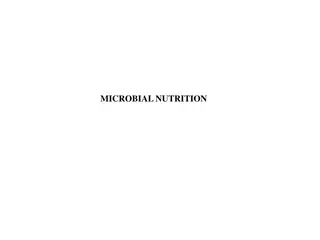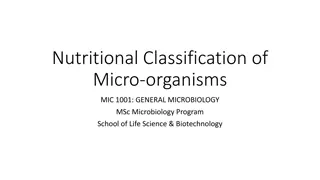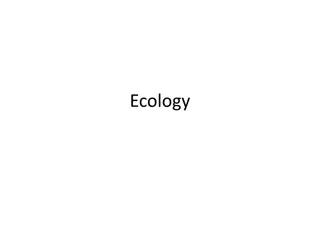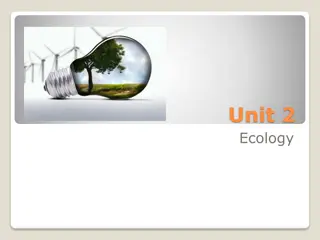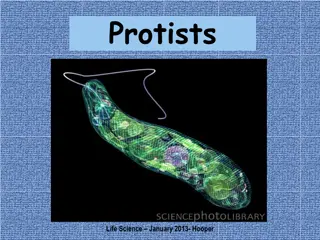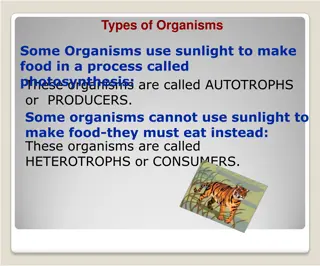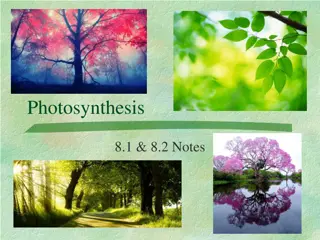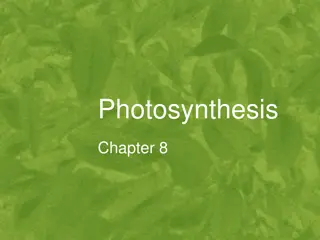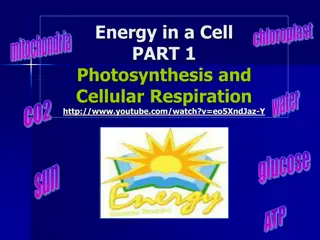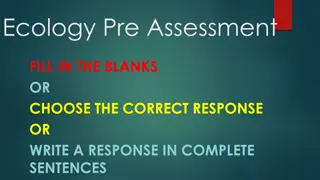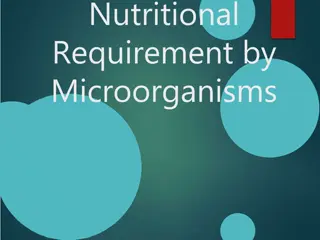Understanding Living Things: An Overview of Classification
Living things share common characteristics like being made of cells, responding to the environment, and reproducing. Macromolecules in cells help them function, and unicellular and multicellular organisms differ in structure. The levels of organization in multicellular organisms are explained, along
0 views • 18 slides
Understanding Microbial Nutrition and Growth Factors
Microbes require carbon for metabolic activities, with organisms categorized as heterotrophs or autotrophs based on their carbon source. In addition to carbon, macronutrients like nitrogen, phosphorous, sulfur, potassium, and magnesium are crucial for cell function. Growth factors such as amino acid
0 views • 15 slides
Nutritional Classification of Microorganisms in General Microbiology
Microorganisms are classified based on their nutritional requirements into autotrophs and heterotrophs. Autotrophs can utilize inorganic nutrients or light for energy, while heterotrophs require organic compounds. They are further categorized into four groups: photoautotrophs, photoheterotrophs, che
1 views • 5 slides
Understanding Ecosystems: Structure, Components, and Functions
Ecosystems are intricate units where living organisms interact with each other and the environment. They consist of biotic (living) and abiotic (non-living) components, interrelated in a chain of interactions. Biotic components include autotrophs, heterotrophs, and decomposers, while abiotic compone
0 views • 15 slides
Understanding Ecology and Basic Concepts in Environmental Science
Explore the fundamental concepts of ecology and environmental science, including species, habitat, population, community, autotrophs, heterotrophs, environment components, food chains, and trophic levels. Learn about the intricate relationships between living organisms and their surroundings in this
0 views • 35 slides
Understanding Ecosystems: A Beginner's Guide to Ecology
Explore the fascinating world of ecosystems with Mrs. Hart in this informative biology lesson. Discover the components of ecosystems, from biotic to abiotic factors. Learn how energy flows through the ecosystem, with autotrophs producing energy and heterotrophs consuming it. Identify different types
0 views • 33 slides
Understanding Energy Flow in Ecosystems: A Visual Guide
Explore the intricate dynamics of energy flow in ecosystems through a collection of visually engaging images depicting autotrophs, heterotrophs, food chains, ecological pyramids, and more. Dive into the concept of trophic levels, food webs, and feeding relationships, unraveling the journey of energy
0 views • 13 slides
Understanding Energy Flow in Ecology
Living things require energy to perform functions that keep them alive. This energy is obtained through food consumption, which contains chemical energy stored in molecules. Various processes such as decomposition and synthesis involve energy release and storage in living organisms. Heterotrophs obt
0 views • 18 slides
Understanding Energy Flows and Matter Cycles in Living Systems
Interactions among living systems and their environment involve the movement of matter and energy. Energy flows through trophic levels, starting with primary producers like plants and autotrophs converting solar energy. It then progresses to primary consumers, secondary consumers, and tertiary consu
1 views • 15 slides
Exploring the World of Protists: A Kingdom of Diversity
Protists are eukaryotes that cannot be classified as plants, animals, or fungi. They thrive in moist environments and showcase a remarkable diversity within the Kingdom Protista. From animal-like protozoa to plant-like autotrophs and fungus-like heterotrophs, this kingdom contains a wide array of un
0 views • 18 slides
Exploring the Diverse World of Protists Through Microscopic Observations
During this lab exercise, a wide variety of protists were observed, showcasing the diverse characteristics and behaviors within this group. The classification of protists is continuously evolving, focusing on convenience rather than evolutionary relationships. From autotrophs to heterotrophs with an
0 views • 20 slides
Understanding Cellular Respiration: Energy Production in Organisms
Organisms can be classified into autotrophs that use sunlight for photosynthesis and heterotrophs that rely on consuming food. Regardless of food source, all organisms obtain energy through cellular respiration, a process that converts stored chemical energy into ATP. This energy currency is essenti
0 views • 21 slides
Understanding Photosynthesis: Energy Conversion in Plants
Photosynthesis is a vital process where plants convert sunlight, carbon dioxide, and water into glucose and oxygen. This energy conversion is crucial for sustaining life on Earth, as it provides food for organisms and releases oxygen into the atmosphere. The process involves the utilization of chemi
0 views • 21 slides
Understanding Energy and Photosynthesis in Living Organisms
This content delves into the fundamental concepts of energy in living organisms, exploring topics such as the role of ATP as a chemical fuel, energy storage and release mechanisms, the similarities and differences between ATP and glucose, and the energy sourcing processes of heterotrophs and autotro
0 views • 29 slides
Understanding Energy Transformations in Cells
Explore the intricate processes of photosynthesis and cellular respiration, vital for energy production in cells. Discover how radiant energy from the sun is converted into chemical energy like glucose and ATP. Uncover the significance of energy for various metabolic functions in cells, including ac
0 views • 17 slides
Ecology Pre-Assessment Questions
This assessment covers topics related to ecology, including food chains, energy pyramids, organism relationships, and ecosystem components. Questions range from identifying correct food chain sequences to defining autotrophs and heterotrophs. Students are prompted to understand how energy flows thro
0 views • 29 slides
Understanding Nutritional Requirements of Microorganisms
Nutritional requirements of microorganisms play a crucial role in their growth and functionality. The essential nutrients include carbon, oxygen, iron, macroelements, micronutrients, and trace elements. Microorganisms need a balanced mixture of nutrients for biosynthesis, energy release, and various
0 views • 22 slides

